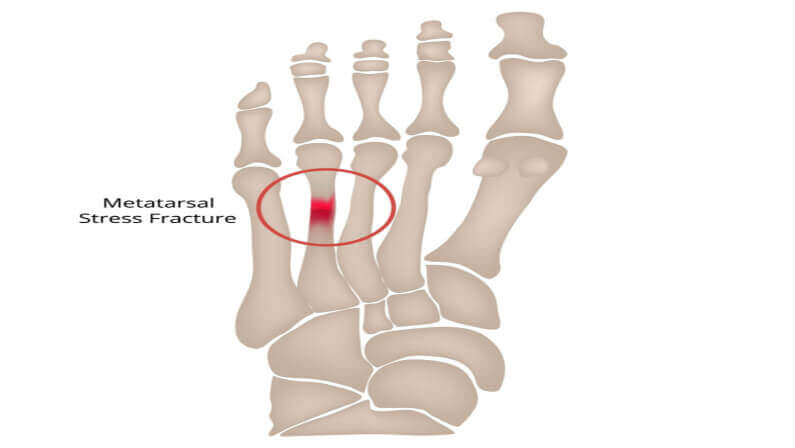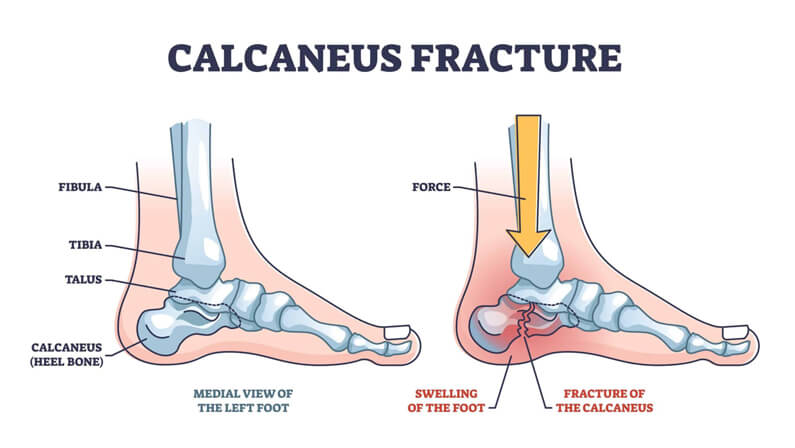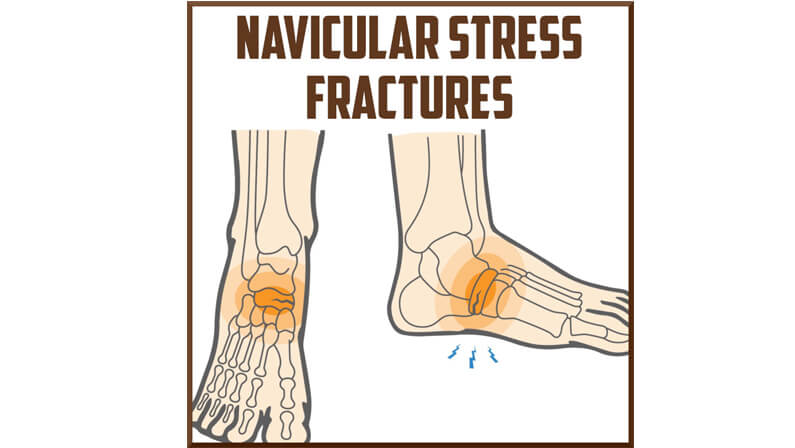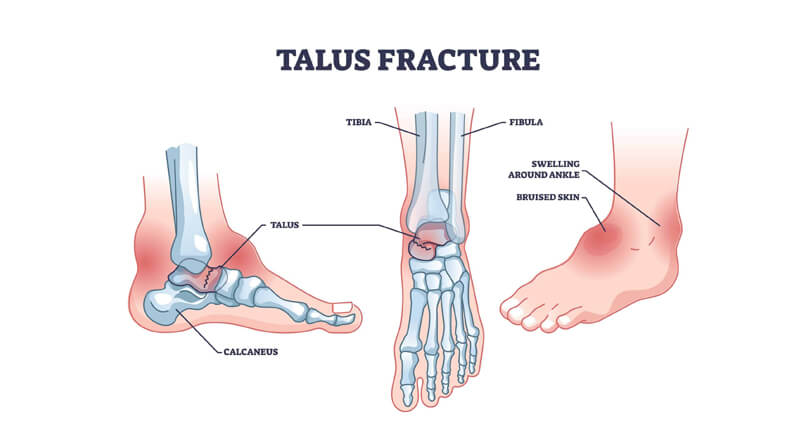Tiny fissures in a bone are known as stress fractures. They result from overuse and repetitive force, such as repeatedly jumping up and down or running vast distances. Stress fractures may also occur as a result of regular use of a bone that has been weakened by an illness like osteoporosis.
In this article, we will know the causes, symptoms, prevention, and how to treat a stress fracture in the foot.
What is a stress fracture?
A stress fracture is characterized by a small crack or extensive bruising within the bone. Overuse injuries frequently lead to stress fractures. They develop gradually due to microscopic bone damage brought on by repeated pressures.
What causes a stress fracture
An abrupt increase in the quantity or intensity of activity might lead to stress fractures.
Here are other factors:
- Utilizing improper training methods or athletic techniques
- An abrupt change in activity level
- Exercise on different surfaces, such as moving from a soft cover (like an indoor track) to an outside gravel or concrete surface
- Running on a sloping track or highway
- Using substandard gear or footwear
- Engaging in repetitive motions while participating in some high-impact sports
- Having a diet with insufficient calories for the amount of exercise you do
- Being deficient in vitamin D
Stress fracture symptoms

Pain is the most prevalent sign. It typically comes on gradually and worsens with weight-bearing exercises.
Among other signs of a stress fracture are the following:
- Swelling at the fractured site
- Bruising
- Sensitivity to touch or “pinpoint pain” when the bone is touched
- Pain that starts after beginning activity and goes away after resting.
- Persistent discomfort lasts the entire duration of the activity and persists after it is over
- Aches and pains come up during rest, everyday motion, or walking
- Hopping on one leg makes the pain worse, as does being unable to transfer your weight or hop on the injured leg or foot
What bones in the foot and ankle are affected by a stress fracture?
Stress fractures frequently occur in the lower leg and foot’s weight-bearing bones. The shin bone, or tibia, accounts for 20% to 75% of all stress fractures and is frequently injured during strenuous activity.
It can also happen in the foot. Numerous tiny bones make up the foot, and Metatarsals are the bones that connect to the toes. The metatarsal bones are where stress fractures occur most frequently in the foot and ankle.
Here are other bones in the foot and ankle that are affected by a stress fracture:
Stress Fractures of the Metatarsal Bones

Stress fractures are more common in the foot’s second and third metatarsals, which are thinner (and frequently longer) than the adjacent first metatarsal. Therefore, when one begins to walk or run, the impact will most likely be in this area.
Stress Fractures of the Fifth Metatarsal Base
The stress fracture in this area may start as soreness on the outside of the midfoot, frequently without an immediate injury. It is especially prevalent in top athletes.
The limited blood supply to the fifth metatarsal base makes it difficult to repair stress fractures, and recovery takes longer.
Stress Fractures of the Calcaneus (Heel Bone)

The bone that makes up the foot heel is called the calcaneus. It is the second most typical location for stress fractures on the foot.
When fractured, it frequently manifests as heel discomfort that worsens with exercise. This soreness may be comparable to that brought on by bone spurs in the heel or plantar fasciitis, an inflammation of the connective tissue on the bottom of your foot.
Stress Fractures of the Navicular

One of the bones in the center of the foot is called the navicular. Weight-bearing and other physical activities, such as running or jumping, worsen the pain.
The navicular bone is not frequently linked to stress fractures. Therefore, making the diagnosis can occasionally be challenging. If the doctor suspects you have a navicular stress fracture, they could request a CT or MRI scan.
This injury may occasionally need to be treated with a cast and a few weeks of no weight-bearing. Surgery is typically advised for this case to stabilize the bones and hasten recovery.
Stress Fracture of the Talus

One of the bones in the foot’s heel is called the talus. The talus bone is the bone that the tibia, or shin bone, rests on at the top of the ankle.
Stress fractures are not frequently found in bones. However, it may result in heel or ankle pain when it happens. Football players and track and field competitors are more likely to suffer from a stress fracture of the talus.
Stress Fracture of the Sesamoids

Two tiny bones called sesamoids are found in the ball of the foot, just below the big toe joint. The big toe’s muscles use these bones as a pulley to help it move normally when walking and running.
Additionally, sesamoids absorb the weight put on the ball of the foot during movement and act as a weight-bearing surface for the first metatarsal bone, the long bone that connects to the big toe.
Therefore, sesamoid injuries are linked to sports like basketball, football, tennis, sprinting, and dance, that place a lot of pressure on the foot’s ball.
How is a stress fracture diagnosed?
When a stress fracture is suspected, proceed to the most reliable emergency care facility, like Aether Health – Kingwood ER, urgent care in Kingwood, Texas.
And to determine whether you have a stress fracture and the severity of the fracture, the doctor may need to perform several tests.
These tests might be:
Physical examination
The initial test would involve the risk factors for a stress fracture. The doctor needs the following information: medical background, work, activities, and current medication taking will be asked.
X-Rays
A stress fracture, however, might be challenging to detect on an X-Ray because the bone frequently looks normal, and the minute breaks aren’t visible on the image.
In reality, X-rays only detect roughly 2/3 of stress fractures. Therefore, it may be difficult to diagnose using X-rays unless it has already begun to heal.
Bone scan
Stress fractures that are undetectable on an X-Ray may be seen using a bone scan.
It works by injecting a radioactive material, called a tracer, into the bloodstream. In the places where the bone is being repaired, the tracer settles and accumulates in the bone. As a result, the stress-fractured area will be visible on the bone scan as being darker than the uninjured area.
Magnetic resonance imaging (MRI)
MRI is preferred in most cases because no radiation exposure is involved, and takes less time than other imaging tests. In addition, it is better at identifying various soft tissue or bone problems.
It uses a huge magnet, radio waves, and a computer to create clear human-body photographs.
How is a stress fracture treated?

Stress fractures can be treated differently depending on the location and severity.
The treatments include:
- Rest. First, you should rest for roughly two to eight weeks to recover.
- Ice. An easy treatment that can be done at home is putting an ice pack for 10 minutes on the injured area.
- Elevation. Elevation helps lessen the swelling and should be done right by raising the foot above the heart level — while lying on one’s back.
- Pain medication. Taking pain medication helps relieve pain and swelling.
- Casting. To maintain the bones in the foot in a fixed position, the doctor might need to apply a cast or fracture boot. Casting also helps relieve the strain on the leg and promotes healing.
- Protective footwear. Protective footwear like a stiff-soled shoe, a wooden-soled sandal, or a post-op shoe with a rigid sole help reduce stress on the foot or leg.
- Surgery. In the worst-case scenario, surgery is required for some stress fractures to heal properly.
How to prevent stress fractures
Take note of these reminders:
- Make changes slowly. When introduced to new activities, especially sports, start slowly and gradually increase the time, speed, and distance.
- Use proper footwear. Limiting the amount of stress on the foot and leg bones by wearing supportive shoes may help avoid stress fractures.
- Cross-train. Including low-impact exercises in one’s fitness routine will help avoid repeatedly pressuring one area of the body.
- Get proper nutrition. Maintain a balanced diet rich in foods that include calcium and vitamin D to keep your bones strong.
How long does it take to recover from a stress fracture?
The period of recovery is on a case-to-case basis. When there’s still pain, the bone in the area has not yet healed.
However, the average time for a stress fracture to heal is 6 to 8 weeks. More severe cases can take longer. Stress fractures that are chronic or occur in bones with insufficient blood supply may also take longer to heal.
Consult the doctor before proceeding to normal activities.
When it happens
You should not take stress fractures lightly. Instead, please proceed to the emergency care nearest to have it diagnosed and treated immediately. Kingwood, Texas, residents may run to Aether Health – Kingwood ER for urgent care and emergency needs.




